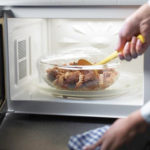In today’s fast-paced lifestyle, cooking has become more challenging than ever. As a result, many people turn to modern cooking appliances such as rice cookers or microwaves to save time. But are these tools suitable for making soup? In this article, we will compare the pros and cons of cooking soup on a stovetop, in a rice cooker, and in a microwave to help you make the optimal choice for your family’s meals.
1. Cooking Soup on a Stovetop
Stovetop is the traditional cooking method and is the most popular among Vietnamese families. Cooking soup on a stovetop has its pros and cons that need to be considered before choosing this method.
Pros of Cooking Soup on a Stovetop
-
Tasty and flavorful soup: Cooking soup on a stovetop allows for better temperature control, enabling longer simmering of vegetables and bones, resulting in more flavorful and tasty soup.
-
Nutrient retention: Stovetop cooking minimizes the destruction of vitamins and minerals in food due to high temperatures.
-
Easy adjustments: Cooking soup on a stovetop lets you easily adjust the flavor to your personal preference by seasoning directly during the cooking process.
-
Cost-effective: Stovetop pots are affordable and widely available compared to other modern cooking appliances.
 Pros of Cooking Soup on a Stovetop
Pros of Cooking Soup on a Stovetop
Cons of Cooking Soup on a Stovetop
-
Time-consuming: Cooking soup on a stovetop usually takes longer than other methods, especially when simmering bones or preparing intricate soups.
-
Requires monitoring: Stovetop cooking demands constant attention to prevent soup from boiling over or burning.
-
Difficult to clean: Some stovetop pots can be challenging to clean, especially after cooking oily soups.
 Cons of Cooking Soup on a Stovetop
Cons of Cooking Soup on a Stovetop
Related: Learn these 4 unbeatable tricks to impress your family
2. Cooking Soup in a Rice Cooker
Rice cookers are not just for cooking rice anymore; they can also prepare various dishes, including soup. Cooking soup in a rice cooker has its conveniences and advantages, but there are also some drawbacks to note.
Pros of Cooking Soup in a Rice Cooker
-
Convenient and time-saving: Cooking soup in a rice cooker is incredibly convenient and time-saving. Simply add the ingredients, select the appropriate cooking mode, and let the cooker do the rest.
-
Safe: Rice cooker soup minimizes the risk of burns compared to gas stove cooking.
-
Keeps soup warm: Rice cookers can keep soup warm for an extended period, ensuring it stays hot and tasty.
-
Easy to clean: Rice cookers typically have a non-stick coating, making cleanup a breeze.
 Pros of Cooking Soup in a Rice Cooker
Pros of Cooking Soup in a Rice Cooker
Cons of Cooking Soup in a Rice Cooker
-
Difficult flavor adjustments: It can be challenging to adjust the flavor of soup cooked in a rice cooker during the cooking process, unlike stovetop cooking.
-
Prone to burning: Soup in a rice cooker may burn if you add too much liquid or select an inappropriate cooking mode.
-
Limited capacity: Rice cookers typically have smaller capacities, making them unsuitable for cooking large batches of soup.
-
Limited cooking modes: Some rice cookers only offer a basic soup-cooking mode without additional options.
 Cons of Cooking Soup in a Rice Cooker
Cons of Cooking Soup in a Rice Cooker
Related: Check out these tasty and convenient tips
3. Cooking Soup in a Microwave
Microwaves are modern kitchen appliances that have gained popularity in recent years. Cooking soup in a microwave has its pros and cons that need to be considered before choosing this method.
Pros of Cooking Soup in a Microwave
-
Fast and efficient: Microwave soup cooking is the quickest method, taking only a few minutes to prepare.
-
Convenient: Microwave soup cooking is incredibly convenient; simply place the ingredients in a suitable bowl, set the timer, and you’re done.
-
Nutrient retention: Microwave cooking minimizes the destruction of vitamins and minerals in food due to shorter cooking times.
-
Energy-efficient: Microwave soup cooking consumes less energy than gas or electric stoves.
 Pros of Cooking Soup in a Microwave
Pros of Cooking Soup in a Microwave
Cons of Cooking Soup in a Microwave
-
Difficult flavor adjustments: It can be challenging to adjust the flavor of soup cooked in a microwave during the cooking process, similar to stovetop cooking.
-
Vegetable texture changes: Microwave cooking may cause vegetables to become mushy and lose their crispness.
-
Limited ingredient options: Not all ingredients are suitable for microwave soup cooking.
-
Risk of fire: Microwave soup cooking carries a risk of fire if inappropriate containers are used or too much liquid is added.
 Cons of Cooking Soup in a Microwave
Cons of Cooking Soup in a Microwave
Related: Discover the top 20 you may not know
Each method of cooking soup, whether on a stovetop, in a rice cooker, or in a microwave, has its own set of pros and cons. The best method depends on your needs, preferences, and circumstances.
In this article, we compared the pros and cons of cooking soup on a stovetop, in a rice cooker, and in a microwave. Soup is an indispensable part of Vietnamese family meals. A bowl of refreshing, sweet soup balances nutrition and stimulates the taste buds, making meals more enjoyable. Choosing the right soup-cooking method will help you create delicious and nutritious soups for your family.






































